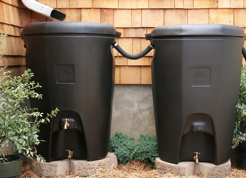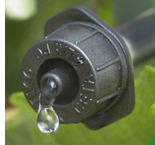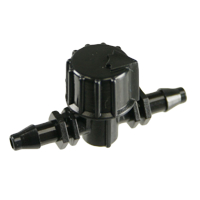Drip Irrigation Systems for Gravity Feed
An increasing number of gardeners are currently using or considering the use of gravity-feed drip irrigation systems to water their plants. A typical gravity feed system consists of water stored in one or more holding tanks and utilizing the natural water pressure created by gravity, the water is directed through drip irrigation tubing and emitters which distributes the water to the plants. Water stored in tanks can come from sources such as municipal water supplies, wells, ponds, lakes, streams, or rivers.
 Rainwater can also be easily collected using various methods. Rainwater can help to improve the health of your gardens, lawns, and trees since it is naturally soft water devoid of minerals and chemicals. Besides helping the environment, an obvious reason for harvesting rainwater is to save money. Depending on the size of your house and the amount of rainfall in your area, you can collect a substantial amount of rainwater and see a significant, positive impact on your water bill. During a one-inch rainfall, you can collect about a half gallon of water per square foot of roof. It's easy to calculate your own rainfall potential. First, estimate the square footage of your roof, then divide that number by two. That's how many gallons your roof will collect during a one-inch rainfall. For example, one inch of rain falling on a 1,000-square-foot catchment area can generate about 500 gallons of captured rainwater!
Rainwater can also be easily collected using various methods. Rainwater can help to improve the health of your gardens, lawns, and trees since it is naturally soft water devoid of minerals and chemicals. Besides helping the environment, an obvious reason for harvesting rainwater is to save money. Depending on the size of your house and the amount of rainfall in your area, you can collect a substantial amount of rainwater and see a significant, positive impact on your water bill. During a one-inch rainfall, you can collect about a half gallon of water per square foot of roof. It's easy to calculate your own rainfall potential. First, estimate the square footage of your roof, then divide that number by two. That's how many gallons your roof will collect during a one-inch rainfall. For example, one inch of rain falling on a 1,000-square-foot catchment area can generate about 500 gallons of captured rainwater!
A rain barrel is only one of many types of cisterns used for storing water intended for irrigation. Much larger holding tanks, multiple tanks, and even converted 55-gallon drums are all commonly used cisterns. A holding tank set on the ground works well when it is full of water and then stops working as the water level drops. To create good water distribution uniformity within the drip irrigation system, it is often necessary for the water source to be elevated above the emitters. Elevation creates water pressure, and adequate pressure is necessary for good uniformity. For every 10 feet of elevation, you can expect to achieve 4.3 pounds per square inch (psi) of water pressure. Ideally, you would want to achieve at least 15 psi of water pressure, but the holding tank would have to be 35 feet off the ground. This amount of elevation is almost never achieved unless you have a hillside you can utilize, but we find that most of our customers that choose a rain collection system either do so out of necessity and/or are looking for a greener solution to water their plants and are willing to work within the constraints of the low and sometimes uneven pressure of a gravity feed system.
The lower water pressures inherent in gravity feed systems can create problems with drip emitter operation and  watering uniformity. The first drip emitter on a length of irrigation tubing will likely put out more water in 30 minutes than the last drip emitter will. In addition, most standard electric-actuated irrigation valves will not work with these systems due to low water pressure. To automate these systems, you usually need a more expensive motor-operated valve. Many gardeners interested in using gravity feed systems often aren't interested in anything fancy and just turn the drip system on and off manually. A recent addition to our line of hose bibb water timers is the Irritec GreenTimer EVO. This zero-pressure battery-operated timer has a mechanical valve and does not require water pressure to open and close the valve.
watering uniformity. The first drip emitter on a length of irrigation tubing will likely put out more water in 30 minutes than the last drip emitter will. In addition, most standard electric-actuated irrigation valves will not work with these systems due to low water pressure. To automate these systems, you usually need a more expensive motor-operated valve. Many gardeners interested in using gravity feed systems often aren't interested in anything fancy and just turn the drip system on and off manually. A recent addition to our line of hose bibb water timers is the Irritec GreenTimer EVO. This zero-pressure battery-operated timer has a mechanical valve and does not require water pressure to open and close the valve.
The type of dripper you use is another important consideration. Some pressure-compensating drippers with internal diaphragms will not work well with a gravity feed system since they require a minimum amount of water pressure to activate. Other pressure-compensating drippers, specific ones with turbulent flow technology, can operate at very low water pressures (Pressure Compensating Dripper). Just about any Non PC dripper will flow at very low pressure but will not regulate the flow at these low pressures. This is where the fluctuations in flow come into play. The first emitters will often flow more water than the last ones in the line or any that are located at lower elevations will emit more water than those at a higher elevation in the system. Micro in-line valves are often used when the water supply is considered dirty, referring to water not thoroughly filtered and not from a municipal water supply. These valves  have a larger orifice than standard drippers and are much less susceptible to clogging (Micro In-Line Shutoff Valve). Drip line tubing and drip tape can be compatible with gravity feed systems as long as the water source is thoroughly filtered and can produce the water flow rate required by the system design.
have a larger orifice than standard drippers and are much less susceptible to clogging (Micro In-Line Shutoff Valve). Drip line tubing and drip tape can be compatible with gravity feed systems as long as the water source is thoroughly filtered and can produce the water flow rate required by the system design.
We recommend that you start out slowly when setting up your gravity feed system and test how well it works. You can then make modifications as needed to your design before investing in more materials you might not need. Remember the key to success if you have problems is almost always to raise the height of the tank. A lot of people give up without trying that simple solution! Drip Depot has developed Drip Irrigation Gravity Feed Kits to help overcome many of the systemic issues described above.
See additional resources for gravity irrigation below.
Using the Force: Gravity Feed Drip Systems